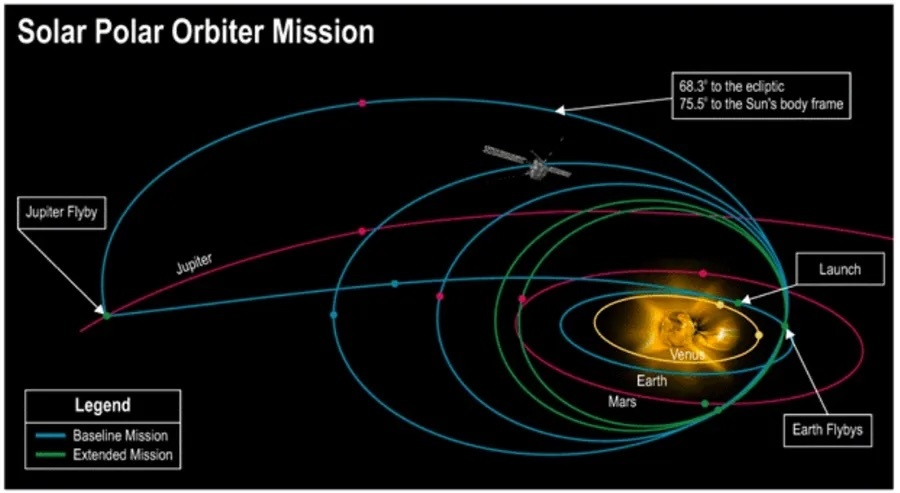9.12.2024

The trajectory of the proposed Solar Polar Orbiter mission that would enable it to fly over the poles of the sun. Credit: Composed by AJ Galaviz III, Southwest Research Institute; Sun image from Hassler et al.
WASHINGTON — A new decadal survey for solar and space physics recommends that NASA’s heliophysics program pursue two billion-dollar missions even as the agency proposes to cancel a recommendation from the previous decadal.
The National Academies released Dec. 5 the decadal survey for heliophysics from 2024 to 2033, advocating that NASA, the National Science Foundation and the National Oceanic and Atmospheric Administration pursue an ambitious program of ground- and space-based facilities to study the sun and its interaction with the Earth.
Those recommendations included, for NASA, two heliophysics flagship missions to begin work on in the next decade. One, called Links, features more than two dozen spacecraft in several orbits to study the magnetosphere and its dynamics. The report recommended starting development of Links in 2027 with launches no earlier than 2035, at an estimated cost of $1.86 billion.
“It discovers the connections across regions and scales in the near-Earth space environment,” said Stephen Fuselier of the Southwest Research Institute, one of the co-chairs of the steering committing for the decadal survey, at a Dec. 5 briefing. “You get a global and a mesoscale context for the dynamics in this region.”
The other flagship mission, Solar Polar Orbiter, would go into a high-inclination orbit around the sun’s polar regions, which cannot be seen from the Earth or most other missions. The spacecraft would require a Jupiter gravity assist and several Earth gravity assists to go into that orbit. The decadal estimated the cost of the mission to be $2.08 billion, with work starting in 2029 for a launch in 2037.
“The Ulysses spacecraft flew over the poles of the sun, but it had no imaging capability,” he said, something the proposed mission would provide to study the behavior of the sun’s magnetic fields at the poles. “It’s critical to the understanding of the cyclic behavior of solar activity.”
Those missions, among other recommendations for ground-based facilities and spacecraft, are intended to build on the data from a top priority from the previous decadal survey, the Geospace Dynamics Constellation (GDC). It would fly six spacecraft to study the interaction of the magnetosphere with the upper atmosphere and support space weather studies.
However, after NASA sought a three-year delay in GDC in its fiscal year 2024 budget proposal, the agency proposed canceling GDC outright in its 2025 proposal, “given other priorities in this request.” Congress has not yet passed a 2025 appropriations bill, although the Senate version was critical of that proposed cancellation.
The leaders of the decadal survey emphasized the importance of the mission, which the report estimated would have a total cost of $1.2 billion. “GDC is an important part of the science that we want to do in the next decade,” said Robyn Millan of Dartmouth College, the other co-chair of the decadal, at the briefing. “We really hope that this decadal survey kicks it off again in our reaffirming of the importance of it as part of the program of record.”
Carrying out the missions in the decadal will require significant funding. The decadal recommended that NASA’s heliophysics budget, $805 million in fiscal year 2024 but proposed to decrease to $786.7 million in 2025, should increase to $1 billion in 2026. It recommended annual increases of 8.25% after that, reaching $1.74 billion by 2033, more than double its current budget.
However, the difficulties faced by GDC raise questions about NASA’s ability to fund the flagships proposed in the new decadal. “Budget is always an issue. We’ve got great science and to do this program that we put forward is going to require investment,” Millan said. “But we’ve seen additional investment. We’ve seen other divisions of NASA grow at this same level that we’re recommending when they’re proposing to do really high priority and exciting science.”
The decadal survey included an alternative, flat budget profile for NASA heliophysics that assumes growth only at the projected rate of inflation. That funding level is too low to support work on GDC, Links or Solar Polar Orbiter under the schedules and funding profiles included in the report.
“We were asked to do an ambitious but realistic program. The program is very ambitious on the science,” Fuselier said. “It is realistic because it is achievable in this next decade with the proper investment.”
“This is an ambitious decadal survey, and we’re excited about that,” Joe Westlake, director of NASA’s heliophysics division, said at the briefing. He did not offer any specific comments about the programs included in the report or NASA’s plans to review it, offering instead broad praise for the study. “This is the voice of our community, the voice of the scientists, and this vivid vision for our future in the next 10 years.”
Quelle: SN
